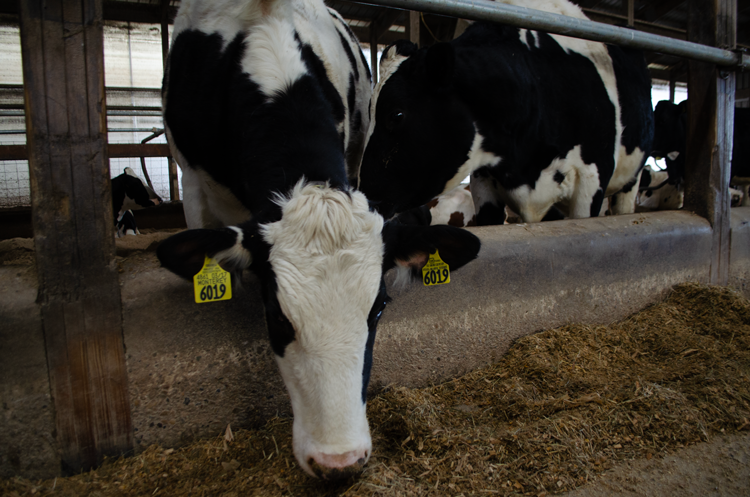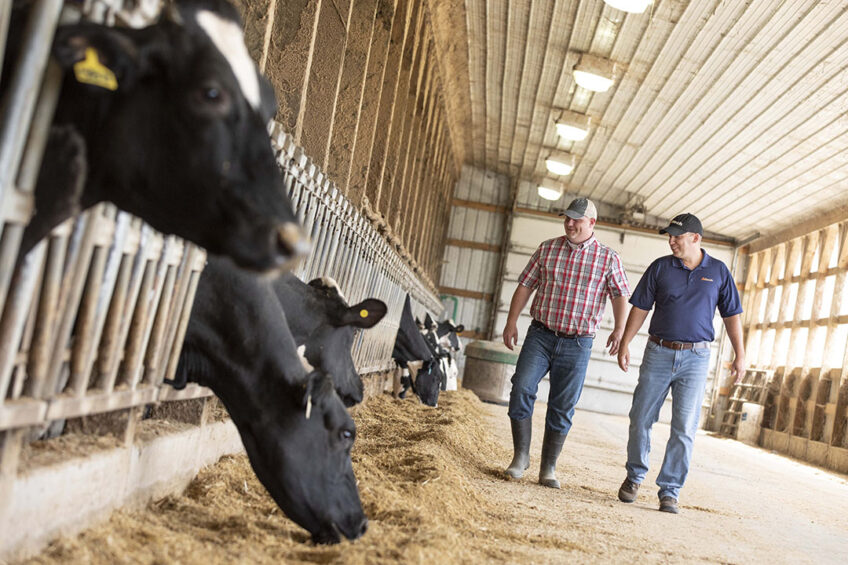Learn how rumen-protected methionine boosts milk fat and lowers culling rates in Holstein cows. Ready to improve your herd’s health?
Summary: Feeding rumen-protected methionine to Holstein cows during the peripartum period has remarkably improved milk fat content and reduced culling rates within commercial herds. Rumen-protected methionine transforms feeding strategies by targeting specific nutritional needs during a critical cycle phase in a cow’s lifecycle. RPM enhances protein synthesis, metabolic function, and keratin production, particularly benefitting high-productivity Holsteins and boosting lactation performance under heat stress. A meta-analysis from 2010 to 2022 highlighted RPM’s superiority over choline during the peripartum period, thereby increasing milk output, herd health, and milk quality by raising milk fat content by 0.2%. These advancements underscore RPM’s significant impact on dairy farm productivity and animal welfare.
- Rumen-protected methionine (RPM) optimizes feeding strategies during the peripartum period.
- Enhances protein synthesis and metabolic functions in high-yielding Holstein cows.
- Significantly improves milk fat content and overall milk quality.
- Proven to reduce culling rates within commercial herds.
- More effective than choline in boosting lactation performance during heat stress.
- RPM contributes to better herd health and higher productivity.

Picture a thriving dairy farm where every Holstein cow is at its peak, producing the highest quality milk, and culling rates are at their lowest. The secret to this success? It’s the transformative power of rumen-protected methionine, a simple yet potent treatment. You can significantly increase milk fat content and reduce culling rates by feeding rumen-protected methionine at the critical peripartum phase. This crucial vitamin can unlock your herd’s full potential, ushering in a new era of production and profitability.
Understanding Rumen-Protected Methionine
Methionine is not just any amino acid; it’s an essential one that dairy cows cannot produce independently. It plays a unique and crucial role in protein synthesis, metabolic function, and the creation of keratin, which is vital for hoof health. In nursing cows, methionine is also required for optimum milk protein production.
Rumen-protected methionine is a dietary supplement used in dairy cow nutrition to guarantee that methionine, an essential amino acid, is efficiently transported to the small intestine for absorption rather than being destroyed in the rumen. This technique improves dairy cows’ nutritional efficiency and health, producing higher milk output and quality.
Rumen-protected methionine is intended to circumvent the rumen fermentation process. This is often accomplished by encapsulating or coating methionine with compounds that can withstand degradation by rumen microorganisms while dissolving in the small intestine’s lower pH. Here’s the step-by-step process:
- Encapsulation: Methionine is coated with a protective layer, often made from fats or pH-sensitive polymers.
- Rumen Bypass: The encapsulated methionine passes through the rumen without being degraded by the microbial population.
- Release in the Small Intestine: Once in the small intestine, where the environment is less acidic than in the rumen, the protective coating dissolves, releasing the intact methionine for absorption into the bloodstream.
A Game Changer for Holsteins
As you may already know, rumen-protected methionine (RPM) is essential to dairy cow diets. Researchers have been working to guarantee that it provides the most advantages, particularly for high-productivity dairy cows such as Holsteins. New research suggests that including RPM in a cow’s diet significantly improves lactation performance under demanding situations such as heat. Pate et al. found that RPM dramatically increases milk’s protein and fat contents during these stressful times. The results represent a significant milestone in the dairy farming business.
A targeted meta-analysis between 2010 and 2022 extensively analyzed RPM’s influence on dairy cows’ nutritional intake, milk output, accurate milk protein synthesis, and milk fat yield. The research shed light on RPM’s functional duties and offered valuable advice on using it most effectively. Increasing milk fat and protein content increases the value of dairy products, including milk, cheese, and yogurt. As a result, RPM not only improves Holstein cow health and nutrition, but it also benefits the commercial dairy industry.
Interestingly, feeding RPM during the peripartum period was more effective than giving choline. Dairy cows’ postnatal performance increased when RPM was added to their diet before and after birth. This method increased lactation performance and optimal plasma amino acid concentrations, providing nutritional benefits to the cows. This may boost milk output and enhance herd health, benefiting dairy producers financially. The goal is to achieve the ideal RPM feeding ratio while ensuring cow well-being and increased milk output. This study examines the impact of rumen-protected methionine in the total mixed diet before and after the calf’s birth on dairy cow lactation performance and plasma amino acid levels.
Unlocking the Potential: Benefits of Feeding Rumen-Protected Methionine
You’re on the right track if you’ve incorporated rumen-protected methionine (RPM) into your feed regimen. Multiple studies from 2010 to 2022, conducted with rigorous scientific methods, have consistently shown that this supplement improves dairy cattle’s health and output capability. These are anecdotal outcomes and solid evidence of RPM’s efficacy, giving you confidence in its benefits. Cows given rumen-protected methionine saw a significant increase in milk output by 1.5 kg/day.
Indeed, the value of RPM stems from its fantastic persistence. Its changed shape guarantees that it can endure the rumen’s harsh environment. By avoiding the danger of deterioration, high-yielding dairy cows may thoroughly enjoy the beneficial properties of this vitamin. Incorporating RPM into your dairy cows’ diet considerably boosts milk fat and protein content, solving issues about low-quality milk production. Recent research found that methionine supplementation throughout the peripartum period raised milk fat content by 0.2%, thereby improving milk quality.
The advantages extend beyond improved milk quality. Methionine, in its rumen-safe form, has shown to be an ally throughout the searing summer months, assisting cows in dealing with heat stress and enhancing their overall performance. This supplementation has also resulted in a 10% drop in culling rates and the occurrence of metabolic diseases, ensuring optimum animal care while reducing long-term expenses. Using RPM improves both your herd’s health and your financial line, demonstrating your dedication to both.
The direct delivery of methionine to the small intestine offers several benefits:
- Enhanced Milk Production: By maintaining proper methionine levels, dairy cows may produce milk with a higher protein content, which is critical for dairy profitability.
- Improved Milk Quality: Methionine raises milk’s casein content, improving its nutritional value and processing properties.
- Better Animal Health: Adequate methionine promotes improved hoof health and general physiological processes, lowering the likelihood of conditions such as laminitis.
- Efficient Feed Utilization: Protecting methionine from rumen breakdown enables more effective utilization of feed proteins, potentially lowering feed costs.
Feeding RPM before and after calving (during the peripartum period) leads to significant lactation performance gains, as seen by high amino acid concentrations in dairy cow plasma. This precedent-setting decision is supported by other investigations, including the 2020 deep-dive research done by Pate, Luchini, Murphy, and Cardoso. Science has never spoken louder. Adding rumen-protected methionine to your Holstein cows’ diet promotes fat-filled milk output and improves farm stability. Pivot to RPM now and put your herd up for unrivaled success.
The Power of Peripartum Nutrition: A Strategy to Curb Culling Rates
You may wonder how this extraordinary rumen-protected methionine (RPM) contributes to lower culling rates. Buckle up because we’re about to discover some incredible details. Culling rates in Holstein cows fell by 5% with the introduction of rumen-protected methionine. It is vital to note that the peripartum interval, which lasts three weeks before and after parturition, is a critical time of metabolic shift for dairy cows. Dietary shortages in this crucial period might cause health problems, increasing culling rates. This is when RPM comes into play.
Researchers discovered that RPM had a much more significant influence on postpartum performance in cows given with it than choline during periportal intervals. This supplement may help increase energy-corrected milk output, protein content, and nitrogen efficiency. RPM was also shown to improve embryo size and fertility in multiparous cows—a significant result given that a more extensive, healthier calf has a greater chance of survival and production. A recent study of 470 multiparous Holstein cows found that RPM improved lactation performance even under heat stress, indicating that its effects do not decline under less-than-ideal settings.
RPM is more than a nutrition supplement; it is a game changer focusing on dairy cows’ long-term health and production, reducing culling rates. Implementing a comprehensive peripartum feeding strategy that includes RPM may significantly boost a commercial herd’s performance.
The Bottom Line
As we conclude, consider how rumen-protected methionine transforms the dairy industry’s future. This innovative supplement has changed the game by drastically increasing milk fat content and lowering culling rates in Holsteins. These significant results have raised expectations for high-quality dairy products and long-term profitability in large-scale enterprises. While critical details, such as the mechanics of methionine supply, remain unknown, ongoing research supported by business collaborations promises a better future. The complicated interaction of nutrition and energy is critical. With rumen-protected methionine, Holsteins are positioned for more excellent health, increased output, and less culling—a fantastic outcome for the industry.













